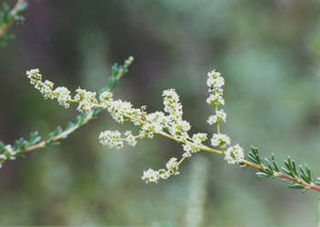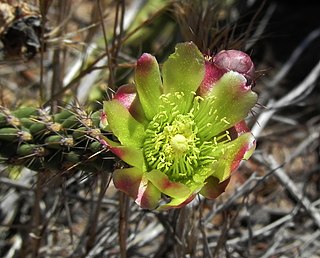
Dendromecon rigida, also called bush poppy or tree poppy, is a shrub or small tree of the Papaveraceae native to California and Baja California.

Adenostoma fasciculatum, commonly known as chamise or greasewood, is a flowering plant native to California and Baja California. This shrub is one of the most widespread plants of the California chaparral ecoregion. Chamise produces a specialized lignotuber underground and at the base of the stem, known as a burl, that allow it to resprout after fire has off burned its stems. It is noted for its greasy, resinous foliage, and its status as one of California's most iconic chaparral shrubs.

Hesperocyparis sargentii is a species of conifer in the family Cupressaceae known by the common name Sargent's cypress. It is endemic to California, where it is known from Mendocino County southwards to Santa Barbara County. This taxon is limited to the Coast Range mountains. It grows in forests with other conifers, as well as chaparral and other local mountain habitat, usually in pure stands on serpentine soils. It generally grows 10 to 15 meters tall, but it is known to exceed 22 meters. On Carson Ridge in Marin County, as well as Hood Mountain in Sonoma County, the species comprises a pygmy forest of trees which do not attain heights greater than 240–360 cm due to high mineral concentrations in the serpentine soil.

Eriodictyon crassifolium, or thickleaf yerba santa, is a shrub in the borage family. "Crassifolium" means "thick leaf." The plant has thick, wooly leaves. It is native to California and Baja California.

Coreopsis californica is a North American species of tickseed in the family Asteraceae.

Hesperocyparis forbesii, with the common names Tecate cypress or Forbes' cypress, is a nonflowering, seed bearing tree species of western cypress native to southwestern North America in California and Baja California. It was formerly known as Cupressus forbesii.

Lycium californicum is a spreading shrub in the nightshade family known by the common names California boxthorn and California desert-thorn.

Allium peninsulare is a North American species of wild onion. It is known by such common names as Mexicali onion and Peninsula onion; the former referring to the Mexican city just south of the US/Mexican border, the latter referring to the Peninsula of Baja California. It is widespread in California, USA, where it grows in the California Coast Ranges, Sierra Nevada foothills, some of the Channel Islands, and Peninsular Ranges. The range extends south into the northernmost part of Baja California and north into southern Oregon.

Eryngium aristulatum, known by the common names California eryngo and Jepson's button celery, is a species of flowering plant in the family Apiaceae.

Euphorbia misera is a semi-succulent shrub in the genus Euphorbia commonly known as the cliff spurge or coast spurge. A drought-deciduous shrub, it is typically found as a gnarled, straggly plant occupying seashore bluffs, hills and deserts. Like other members of its genus, it has a milky sap, which can be found exuding out of the light gray bark when damaged. The alternately-arranged leaves are round and folded in the middle, with small hairs on them. The "flowers" can be found blooming year-round, and are colored maroon or yellow in the center with 5 white to light-yellow petal-like appendages attached outside. This species is native to the Baja California peninsula and Sonora in Mexico, and the coast of Southern California in the United States, where it is a rare species. It is threatened in some localities by the development of its coastal habitat, which tends to be prime locations for high-end residential and commercial developments.

Eriocoma parishii is a species of grass known by the common name Parish's needlegrass.

Astragalus didymocarpus is a species of milkvetch known by the common names Dwarf white milkvetch and Two-seeded milkvetch. It is native to the southwestern United States and northern Mexico, where it can be found in many types of habitat.

Callitriche marginata is a species of aquatic plant known by the common name winged water starwort. Callitriche marginata is native to the west coast of North America from British Columbia to Baja California, where it grows in and around vernal pools.
Draba corrugata is a species of flowering plant in the family Brassicaceae known by the common name Southern California draba.

Malephora crocea is a species of succulent perennial flowering plant in the ice plant family known by the common names 'coppery mesemb' and 'red ice plant'. It is native to Southern Africa but is grown in many other regions of the world, primarily as an ornamental plant, but also as a fireproof groundcover. In parts of Southern California, and south along the coast of Mexico's Baja California state, M. crocea is an introduced species, where it was originally planted as highway landscaping in areas of low rainfall. However, due to the environmental similarities with its native African habitats, the species becomes comfortably well-established and often reseeds prolifically, even becoming a noxious weed in coastal Pacific habitats, including on sandy beaches and areas with seemingly no viable soil. It is also planted along highways in Arizona, and is valued in xeriscaping for its low water needs, its love of direct sun, and its reliable blooming. The flowers are quite popular with pollinators, such as bees, butterflies, and some hummingbirds. The succulent, water-engorged leaves are also sometimes eaten by birds and other animals in times of drought, resulting in a ragged, torn-looking plant. It has been recommended as a groundcover in areas prone to wildfire in southern California due to its low flammability.

Cylindropuntia californica is a species of cholla cactus known by the common name snake cholla. It is primarily found in Baja California, Mexico and the southernmost part of California in the United States. It is characterized by a short, decumbent habit, yellow-green flowers, elongated stems, and short spines. It is mostly found in coastal sage scrub and coastal chaparral habitats, but two varieties in Baja California can be found in foothills and deserts. In California, variety californica is regarded as a rare and threatened plant, with a California Native Plant Society listing of 1B.1, in part due to its limited number of occurrences and threats from development. It formerly was considered to have a larger range due to the inclusion of Cylindropuntia bernardina within it as the variety parkeri.

Penstemon spectabilis is a species of penstemon known by the common name showy penstemon or showy beardtongue. It is a perennial herb native to southern California and Baja California, where it grows in the chaparral, scrub, and woodlands of the coastal mountain ranges.

Rhamnus crocea subsp. ilicifolia, synonym Rhamnus ilicifolia, is a subspecies of flowering plant in the buckthorn family, known by the common name hollyleaf redberry. It is native to western North America, where it is a common plant growing in many types of habitat, including chaparral and wooded areas, from Oregon through California, to Baja California and Arizona.

Pseudoziziphus parryi, synonym Ziziphus parryi, is a species of flowering plant in the buckthorn family known by the common names Parry's jujube, California crucillo, Parry Abrojo, and lotebush.

Bloomeria crocea var. aurea, with the common name golden stars, is a variety of Bloomeria that is endemic to California. When blooming in late spring, its bright colors are distinctive.




















